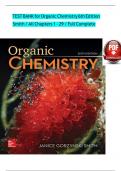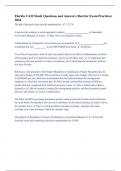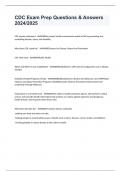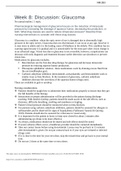TEST BANK for Organic Chemistry 6th Edition
IIll IIll IIll IIll IIll IIll
Smith / All Chapters 1 - 29 / Full Complete
IIll IIll IIll IIll IIll IIll IIll IIll IIll IIll
Page 1
IIll
,Chapter 1 Structure and Bonding
IIll IIll IIll IIll
Chapter 2 Acids and Bases
IIll IIll IIll IIll
Chapter 3 Introduction to Organic Molecules and Functional Groups
IIll IIll IIll IIll IIll IIll IIll IIll
Chapter 4 Alkanes
IIll IIll
Chapter 5 Stereochemistry
IIll IIll
Chapter 6 Understanding Organic Reactions
IIll IIll IIll IIll
Chapter 7 Alkyl Halides and Nucleophilic Substitution
IIll IIll IIll IIll IIll IIll
Chapter 8 Alkyl Halides and Elimination Reactions
IIll IIll IIll IIll IIll IIll
Chapter 9 Alcohols, Ethers, and Related Compounds
IIll IIll IIll IIll IIll IIll
Chapter 10 Alkenes and Addition Reactions
IIll IIll IIll IIll IIll
Chapter 11 Alkynes and Synthesis
IIll IIll IIll IIll
Chapter 12 Oxidation and Reduction
IIll IIll IIll IIll
Spectroscopy A Mass Spectrometry
IIll IIll IIll
Spectroscopy B Infrared Spectroscopy
IIll IIll IIll
Spectroscopy C Nuclear Magnetic Resonance Spectroscopy
IIll IIll IIll IIll IIll
Chapter 13 Radical Reactions
IIll IIll IIll
Chapter 14 Conjugation, Resonance, and Dienes
IIll IIll IIll IIll IIll
Chapter 15 Benzene and Aromatic Compounds
IIll IIll IIll IIll IIll
Chapter 16 Reactions of Aromatic Compounds
IIll IIll IIll IIll IIll
Chapter 17 Introduction to Carbonyl Chemistry: Organometallic Reagents;
IIll IIll IIll IIll IIll IIll IIll
Oxidation and Reduction
IIll IIll IIll
Chapter 18 Aldehydes and Ketones—Nucleophilic Addition
IIll IIll IIll IIll IIll
Chapter 19 Carboxylic Acids and Nitriles
IIll IIll IIll IIll IIll
Chapter 20 Carboxylic Acids and Their Derivatives- Nucleophilic Acyl
IIll IIll IIll IIll IIll IIll IIll IIll
Substitution
IIll
Chapter 21
IIll Substitution Reactions of Carbonyl Compounds at the α-Carbon
IIll IIll IIll IIll IIll IIll IIll IIll
Chapter 22
IIll Carbonyl Condensation Reactions
IIll IIll IIll
Chapter 23
IIll Amines
IIll
Chapter 24
IIll Carbon-Carbon Bond-Forming Reactions in Organic Synthesis
IIll IIll IIll IIll IIll IIll
Chapter 25
IIll Pericyclic Reactions
IIll IIll
Chapter 26
IIll Carbohydrates
IIll
Chapter 27
IIll Amino Acids and Proteins
IIll IIll IIll IIll
Chapter 28
IIll Synthetic Polymers
IIll IIll
Chapter 29
IIll Lipids (Available online)
IIll IIll IIll
Page 2 IIll
, Chapter 1: Structure and Bonding IIll IIll IIll IIll
1. What is the ground-state electronic configuration of a carbon
IIll IIll IIll IIll IIll IIll IIll IIll
atom? A) 1s2, 2s2, 2p5
IIll IIll B) 1s2, 2s2, 2p2 C) 1s2,
I I l l IIll IIll I I l l IIll IIll I I l l
2s2, 2p6
IIll IIll D) 1s2, 2s2, 2p4 I I l l IIll IIll
2. What is the ground-state electronic configuration of a fluorine
IIll IIll IIll IIll IIll IIll IIll IIll
atom? A) 1s2, 2s2, 2p2
IIll Il B) 1s2, 2s2, 2p3 C) 1s2,
I I l l IIll IIll I I l l IIll IIll I I l l
2s2, 2p4
IIll IIll D) 1s2, 2s2, 2p5 I I l l IIll IIll
3. What is the ground-state electronic configuration of a magnesium cation
IIll IIll IIll IIll IIll IIll IIll IIll IIll
(Mg2+)? A)
IIll Il 1s2, 2s2, 2p6 C) 1s2, 2s2, 2p6, IIll IIll IIll IIll
3s2
IIll
B) 1s2, 2s2, 2p6, 3s1 IIll IIll IIll D) 1s2, 2s2, 2p6, 3s2, 3p2 IIll IIll IIll IIll
4. What is the ground-state electronic configuration of a chlorine anion (Cl—
IIll IIll IIll IIll IIll IIll IIll IIll IIll IIll
)?A) 1s2, 2s2, 2p6
Il IIll C) 1s2, 2s2, 2p6, 3s2, 3p5
IIll IIll IIll IIll IIll
B) 1s2, 2s2, 2p6, 3s2, 3p6IIll IIll IIll IIll D) 1s2, 2s2, 2p6, 3s2, 3p4 IIll IIll IIll IIll
5. Which of the following statements about valence electrons is true?
IIll IIll IIll IIll IIll IIll IIll IIll IIll
A) They are the most tightly held electrons. IIll IIll IIll IIll IIll IIll
B) They do not participate in chemical reactions.
IIll IIll IIll IIll IIll IIll
Page 3 IIll
, Chapter 1: Structure and IIll IIll IIll
Bonding
IIll
C) They are the outermost electrons.IIll IIll IIll IIll
D) They reveal the period number of a second-row element.
IIll IIll IIll IIll IIll IIll IIll IIll
6. Which of the following statements about bonding is true?
IIll IIll IIll IIll IIll IIll IIll IIll
A) Covalent bonds result from the transfer of electrons from one element to another.
IIll IIll IIll IIll IIll IIll IIll IIll IIll IIll IIll IIll
B) Ionic bonds result from the transfer of electrons from a metal to a non-metal.
IIll IIll IIll IIll IIll IIll IIll IIll IIll IIll IIll IIll IIll
C) Ionic bonds result from the sharing of electrons between two non-metals.
IIll IIll IIll IIll IIll IIll IIll IIll IIll IIll
D) Covalent bonds result from the sharing of electrons between two metals. IIll IIll IIll IIll IIll IIll IIll IIll IIll IIll
7. Which of the following would you expect to have ionic bonds?
IIll IIll IIll IIll IIll IIll IIll IIll IIll IIll
A) CO B) FBr C) NF3 D) NaCl I I l l I I l l I I l l
8. Which of the following molecules has nonpolar covalent bonds?
IIll IIll IIll IIll IIll IIll IIll IIll
A) HCl B) N2 C) CHCl3 D) NO I I l l I I l l I I l l
9. Which of the following molecules contain both covalent and ionic bonds?
IIll IIll IIll IIll IIll IIll IIll IIll IIll IIll
A) I, II B) IIll I I l l I, IV IIll C) I I l l II, III IIll D) II, IV IIll IIll
10. Arrange the following bonds in decreasing order of ionic character, putting the
IIll IIll IIll IIll IIll IIll IIll IIll IIll IIll IIll
mostionic first.
IIll Il IIll
A) I > II > III > IV
IIll IIll IIll IIll IIll IIll C) IV > III > II > I IIll IIll IIll IIll IIll IIll
B) IV > II > I > III IIll IIll IIll IIll IIll IIll D) IV > II > III > I IIll IIll IIll IIll IIll IIll
11. Which of the following statements correctly describes the typical number of bonds
IIll IIll IIll IIll IIll IIll IIll IIll IIll IIll IIll
forcarbon, nitrogen, and oxygen in most neutral organic molecules?
IIll Il IIll IIll IIll IIll IIll IIll IIll IIll
A) Carbon forms 4 covalent bonds, nitrogen forms 2 covalent bonds and oxygen
IIll IIll IIll IIll IIll IIll IIll IIll IIll IIll IIll
forms 3 covalent bonds.
IIll Il IIll IIll
B) Carbon forms 4 covalent bonds, nitrogen forms 3 covalent bonds and oxygen
IIll IIll IIll IIll IIll IIll IIll IIll IIll IIll IIll
forms 2 covalent bonds.
IIll Il IIll IIll
Page 4 IIll







